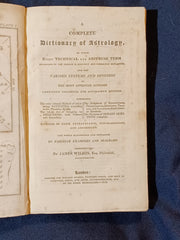Master Key System in Twenty-Four Parts with Questionnaire and Glossary by Charles F. Haanel.
Sold out.
Master Key System in Twenty-Four Parts with Questionnaire and Glossary by Charles F. Haanel. Copyright in 1919 by Charles F. Haanel. Published by Charles F. Haanel. This is a later printing judging by ads in the back about another book published by Haanel dated 1923. 48 pages plus ads. Navy blue cloth covers. Bright gilt lettering on the front cover, but some of the gilt lettering on the spine has come off, or maybe never made it onto the book. I don't see signs of rubbing and the remaining lettering is quite bright. Moderate cover edge wear. Some rubbing and a blemish (a drop of wax?) on the front cover. Light tanning to page block edges. Light soiling to leading page block edge. A couple of 1/4" tears on the leading edges of some of the last pages. Otherwise, no previous owner markings. Binding is tight with no looseness to pages. Not ex-library, not remaindered and not a facsimile reprint. For sale by Jon Wobber, bookseller since 1978. FD10b
"There are many editions of the book. Modern editions mostly do not include the 3-part introduction, the psychological chart*, the question-and-answers section at the end of the book, or the glossary.
The book describes many New Thought beliefs such as the law of attraction,[2] creative visualization and man's unity with God, and teaches the importance of truth, harmonious thinking and the ability to concentrate.[
Along with The Science of Getting Rich, by Wallace D. Wattles, The Master Key System inspired much of the content of Rhonda Byrne's film The Secret (2006), which was later followed by a book of the same name.
It is claimed on the website haanel.com that Charles Haanel received a letter in 1919 from Napoleon Hill, who later went on to write one of the best-selling books of all time, Think and Grow Rich, saying that his own success was due to the principles laid down in The Master Key System." from Wikipedia
*I do not see a psychological chart in this copy.
"There are many editions of the book. Modern editions mostly do not include the 3-part introduction, the psychological chart*, the question-and-answers section at the end of the book, or the glossary.
The book describes many New Thought beliefs such as the law of attraction,[2] creative visualization and man's unity with God, and teaches the importance of truth, harmonious thinking and the ability to concentrate.[
Along with The Science of Getting Rich, by Wallace D. Wattles, The Master Key System inspired much of the content of Rhonda Byrne's film The Secret (2006), which was later followed by a book of the same name.
It is claimed on the website haanel.com that Charles Haanel received a letter in 1919 from Napoleon Hill, who later went on to write one of the best-selling books of all time, Think and Grow Rich, saying that his own success was due to the principles laid down in The Master Key System." from Wikipedia
*I do not see a psychological chart in this copy.








